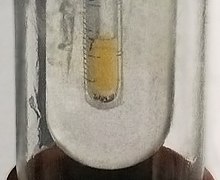 Type: Trace Element
Type: Trace Element
Periodic Element: (F)
RDA: 1.5-4 mg Daily requirement is 0.7 part/million in water.
Importance- To Body:
Contended to hardens bones and teeth. Important for tooth structure; may help prevent dental caries (particularly in children) and osteoporosis in adults. Suppresses bacterial action in mouth.
Distribution- In Body:
* Approx. % of Body Mass
Component of bones, teeth, other body tissues; excreted in urine.
Excess Effects:
Mottling of Teeth
Deficiency Effects:
Tendency toward dental caries, Osteoporosis, Unknown
Sources Food:
Fluoridated water, Toothpaste, Milk, Tea
Sources Environmental/Geographic:
None listed
Supplemental information:

Liquid fluorine (at extremely low temperatures)
|
||||||||||||||||||
| General properties | ||||||||||||||||||
|---|---|---|---|---|---|---|---|---|---|---|---|---|---|---|---|---|---|---|
| Pronunciation | ||||||||||||||||||
| Allotropes | alpha, beta | |||||||||||||||||
| Appearance | gas: very pale yellow liquid: bright yellow solid: alpha is opaque, beta is transparent |
|||||||||||||||||
| Standard atomic weight (Ar, standard) | 18.998403163(6) | |||||||||||||||||
| Fluorine in the periodic table | ||||||||||||||||||
|
||||||||||||||||||
| Atomic number (Z) | 9 | |||||||||||||||||
| Group | group 17 (halogens) | |||||||||||||||||
| Period | period 2 | |||||||||||||||||
| Element category | diatomic nonmetal | |||||||||||||||||
| Block | p-block | |||||||||||||||||
| Electron configuration | [He] 2s2 2p5 | |||||||||||||||||
|
Electrons per shell
|
2, 7 | |||||||||||||||||
| Physical properties | ||||||||||||||||||
| Phase at STP | gas | |||||||||||||||||
| Melting point | 53.48 K (−219.67 °C, −363.41 °F) | |||||||||||||||||
| Boiling point | 85.03 K (−188.11 °C, −306.60 °F) | |||||||||||||||||
| Density (at STP) | 1.696 g/L | |||||||||||||||||
| when liquid (at b.p.) | 1.505 g/cm3 | |||||||||||||||||
| Triple point | 53.48 K, 90 kPa | |||||||||||||||||
| Critical point | 144.41 K, 5.1724 MPa | |||||||||||||||||
| Heat of vaporization | 6.51 kJ/mol | |||||||||||||||||
| Molar heat capacity | Cp: 31 J/(mol·K) (at 21.1 °C) Cv: 23 J/(mol·K) (at 21.1 °C) |
|||||||||||||||||
Vapor pressure
|
||||||||||||||||||
| Atomic properties | ||||||||||||||||||
| Oxidation states | −1 |
|||||||||||||||||
| Electronegativity | Pauling scale: 3.98 | |||||||||||||||||
| Ionization energies |
|
|||||||||||||||||
| Covalent radius | 64 pm | |||||||||||||||||
| Van der Waals radius | 135 pm | |||||||||||||||||
|
||||||||||||||||||
| Miscellanea | ||||||||||||||||||
| Crystal structure | cubic | |||||||||||||||||
| Thermal conductivity | 0.02591 W/(m·K) | |||||||||||||||||
| Magnetic ordering | diamagnetic (−1.2×10−4) | |||||||||||||||||
| CAS Number | 7782-41-4 | |||||||||||||||||
| History | ||||||||||||||||||
| Naming | after the mineral fluorite, itself named after Latin fluo (to flow, in smelting) | |||||||||||||||||
| Discovery | André-Marie Ampère (1810) | |||||||||||||||||
| First isolation | Henri Moissan(June 26, 1886) | |||||||||||||||||
| Named by | Humphry Davy | |||||||||||||||||
| Main isotopes of fluorine | ||||||||||||||||||
|
||||||||||||||||||
Fluorine is a chemical element with symbol F and atomic number 9. It is the lightest halogen and exists as a highly toxic pale yellow diatomic gas at standard conditions. As the most electronegative element, it is extremely reactive: almost all other elements, including some noble gases, form compounds with fluorine.
Among the elements, fluorine ranks 24th in universal abundance and 13th in terrestrial abundance. Fluorite, the primary mineral source of fluorine which gave the element its name, was first described in 1529; as it was added to metal ores to lower their melting points for smelting, the Latin verb fluo meaning "flow" gave the mineral its name. Proposed as an element in 1810, fluorine proved difficult and dangerous to separate from its compounds, and several early experimenters died or sustained injuries from their attempts. Only in 1886 did French chemist Henri Moissan isolate elemental fluorine using low-temperature electrolysis, a process still employed for modern production. Industrial production of fluorine gas for uranium enrichment, its largest application, began during the Manhattan Project in World War II.
Owing to the expense of refining pure fluorine, most commercial applications use fluorine compounds, with about half of mined fluorite used in steelmaking. The rest of the fluorite is converted into corrosive hydrogen fluoride en route to various organic fluorides, or into cryolite which plays a key role in aluminium refining. Organic fluorides have very high chemical and thermal stability; their major uses are as refrigerants, electrical insulation and cookware, the last as PTFE (Teflon). Pharmaceuticals such as atorvastatin and fluoxetine also contain fluorine, and the fluoride ion inhibits dental cavities, and so finds use in toothpaste and water fluoridation. Global fluorochemical sales amount to more than US$15 billion a year.
Fluorocarbon gases are generally greenhouse gases with global-warming potentials 100 to 20,000 times that of carbon dioxide. Organofluorine compounds persist in the environment due to the strength of the carbon–fluorine bond. Fluorine has no known metabolic role in mammals; a few plants synthesize organofluorine poisons that deter herbivores.



